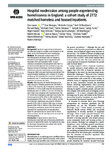Hospital readmission among people experiencing homelessness in England: a cohort study of 2772 matched homeless and housed inpatients
| dc.contributor.author | Lewer, D | |
| dc.contributor.author | Menezes, D | |
| dc.contributor.author | Cornes, M | |
| dc.contributor.author | Blackburn, RM | |
| dc.contributor.author | Byng, Richard | |
| dc.contributor.author | Clark, M | |
| dc.contributor.author | Denaxas, S | |
| dc.contributor.author | Evans, H | |
| dc.contributor.author | Fuller, J | |
| dc.contributor.author | Hewett, N | |
| dc.contributor.author | Kilmister, A | |
| dc.contributor.author | Luchenski, SA | |
| dc.contributor.author | Manthorpe, J | |
| dc.contributor.author | McKee, M | |
| dc.contributor.author | Neale, J | |
| dc.contributor.author | Story, A | |
| dc.contributor.author | Tinelli, M | |
| dc.contributor.author | Whiteford, M | |
| dc.contributor.author | Wurie, F | |
| dc.contributor.author | Yavlinsky, A | |
| dc.contributor.author | Hayward, A | |
| dc.contributor.author | Aldridge, R | |
| dc.date.accessioned | 2021-11-17T14:36:04Z | |
| dc.date.issued | 2021-07 | |
| dc.identifier.issn | 0143-005X | |
| dc.identifier.issn | 1470-2738 | |
| dc.identifier.uri | http://hdl.handle.net/10026.1/18388 | |
| dc.description.abstract |
<jats:sec><jats:title>Background</jats:title><jats:p>Inpatients experiencing homelessness are often discharged to unstable accommodation or the street, which may increase the risk of readmission.</jats:p></jats:sec><jats:sec><jats:title>Methods</jats:title><jats:p>We conducted a cohort study of 2772 homeless patients discharged after an emergency admission at 78 hospitals across England between November 2013 and November 2016. For each individual, we selected a housed patient who lived in a socioeconomically deprived area, matched on age, sex, hospital, and year of discharge. Counts of emergency readmissions, planned readmissions, and Accident and Emergency (A&E) visits post-discharge were derived from national hospital databases, with a median of 2.8 years of follow-up. We estimated the cumulative incidence of readmission over 12 months, and used negative binomial regression to estimate rate ratios.</jats:p></jats:sec><jats:sec><jats:title>Results</jats:title><jats:p>After adjusting for health measured at the index admission, homeless patients had 2.49 (95% CI 2.29 to 2.70) times the rate of emergency readmission, 0.60 (95% CI 0.53 to 0.68) times the rate of planned readmission and 2.57 (95% CI 2.41 to 2.73) times the rate of A&E visits compared with housed patients. The 12-month risk of emergency readmission was higher for homeless patients (61%, 95% CI 59% to 64%) than housed patients (33%, 95% CI 30% to 36%); and the risk of planned readmission was lower for homeless patients (17%, 95% CI 14% to 19%) than for housed patients (30%, 95% CI 28% to 32%). While the risk of emergency readmission varied with the reason for admission for housed patients, for example being higher for admissions due to cancers than for those due to accidents, the risk was high across all causes for homeless patients.</jats:p></jats:sec><jats:sec><jats:title>Conclusions</jats:title><jats:p>Hospital patients experiencing homelessness have high rates of emergency readmission that are not explained by health. This highlights the need for discharge arrangements that address their health, housing and social care needs.</jats:p></jats:sec> | |
| dc.format.extent | 681-688 | |
| dc.format.medium | Print-Electronic | |
| dc.language | en | |
| dc.language.iso | en | |
| dc.publisher | BMJ | |
| dc.subject | homelessness | |
| dc.subject | access to hlth care | |
| dc.subject | health inequalities | |
| dc.subject | record linkage | |
| dc.title | Hospital readmission among people experiencing homelessness in England: a cohort study of 2772 matched homeless and housed inpatients | |
| dc.type | journal-article | |
| dc.type | Journal Article | |
| plymouth.author-url | https://www.webofscience.com/api/gateway?GWVersion=2&SrcApp=PARTNER_APP&SrcAuth=LinksAMR&KeyUT=WOS:000667239600013&DestLinkType=FullRecord&DestApp=ALL_WOS&UsrCustomerID=11bb513d99f797142bcfeffcc58ea008 | |
| plymouth.issue | 7 | |
| plymouth.volume | 75 | |
| plymouth.publication-status | Published | |
| plymouth.journal | Journal of Epidemiology and Community Health | |
| dc.identifier.doi | 10.1136/jech-2020-215204 | |
| plymouth.organisational-group | /Plymouth | |
| plymouth.organisational-group | /Plymouth/Faculty of Health | |
| plymouth.organisational-group | /Plymouth/Faculty of Health/Peninsula Medical School | |
| plymouth.organisational-group | /Plymouth/REF 2021 Researchers by UoA | |
| plymouth.organisational-group | /Plymouth/REF 2021 Researchers by UoA/UoA03 Allied Health Professions, Dentistry, Nursing and Pharmacy | |
| plymouth.organisational-group | /Plymouth/Research Groups | |
| plymouth.organisational-group | /Plymouth/Research Groups/FoH - Community and Primary Care | |
| plymouth.organisational-group | /Plymouth/Research Groups/Institute of Health and Community | |
| plymouth.organisational-group | /Plymouth/Research Groups/Institute of Translational and Stratified Medicine (ITSMED) | |
| plymouth.organisational-group | /Plymouth/Research Groups/Institute of Translational and Stratified Medicine (ITSMED)/CCT&PS | |
| plymouth.organisational-group | /Plymouth/Research Groups/Plymouth Institute of Health and Care Research (PIHR) | |
| plymouth.organisational-group | /Plymouth/Users by role | |
| plymouth.organisational-group | /Plymouth/Users by role/Academics | |
| dc.publisher.place | England | |
| dcterms.dateAccepted | 2020-12-04 | |
| dc.rights.embargodate | 2021-11-19 | |
| dc.identifier.eissn | 1470-2738 | |
| dc.rights.embargoperiod | Not known | |
| rioxxterms.versionofrecord | 10.1136/jech-2020-215204 | |
| rioxxterms.licenseref.uri | http://www.rioxx.net/licenses/all-rights-reserved | |
| rioxxterms.licenseref.startdate | 2021-07 | |
| rioxxterms.type | Journal Article/Review |


